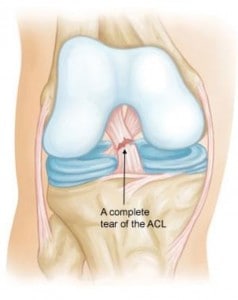The Anterior Cruciate Ligament (ACL) is commonly ruptured playing sport. The problem is repair and rehabilitation for an ACL rupture can take at least 12 months and 25% of professional athletes don’t return to sport and of those who do 30% of the repairs fail. 30% of recreational athletes don’t return to sport.
The Anterior Cruciate Ligament (ACL) is commonly ruptured playing sport. The problem is repair and rehabilitation for an ACL rupture can take at least 12 months and 25% of professional athletes don’t return to sport and of those who do 30% of the repairs fail. 30% of recreational athletes don’t return to sport.



The ACL crosses inside the middle of the knee joint and provides rotational support of the knee.
Non-contact ACL rupture vs. contact ACL rupture
A non-contact ACL rupture can occur with changing direction at high speeds, regaining balance after kicking or even landing after a jump. Contact ACL ruptures occur with collisions with other players.
The operation to repair the ligament requires taking a section of the hamstring or patella tendon and screwing it into the middle of the knee. For the new ligament to ‘take’ in the knee it takes between 6 months to 2 years to mature – no one really knows exactly. But it is definitely weakest and therefore vulnerable to injury at the three-month stage.
If you push it too much at the weak three-month stage, you will not actually hurt your knee. Instead, the ligament will stretch and then fail on return to sport.
There is a huge variation in rehabilitation protocols for an ACL rupture, but there is great research which supports the focus to be on functional ability rather than a time frame. This makes logical sense; you cannot progress into running drills from weighted squats if there is poor movement control, even if you have passed the two-month mark!
So if you rupture your ACL should you have a reconstruction operation??
Yes….if you plan to return to sport that demands pivoting of your knee, as without an ACL, the next knock to your knee will result in so much trauma you will probably not tolerate impact exercise again.
No…. if you are satisfied with straight line running, non-contact sport and can avoid changing direction with high-speed running.

In Summary
Physiotherapy rehabilitation focuses on optimising the placement of the operated leg under the body when running at speed and changing direction.
Operation or no operation, you will need to address the strength of your knee with a structured physiotherapy rehabilitation program.








